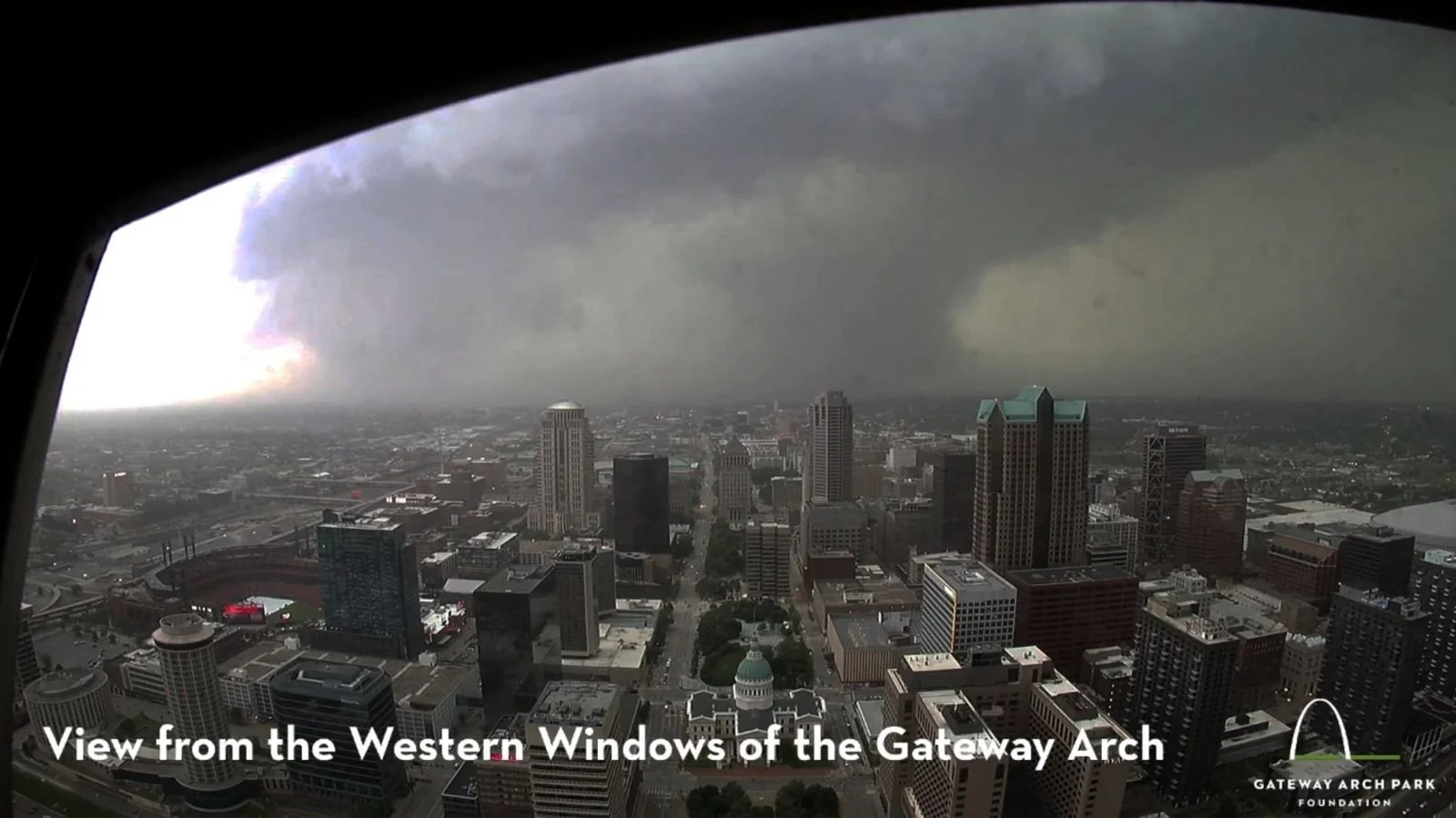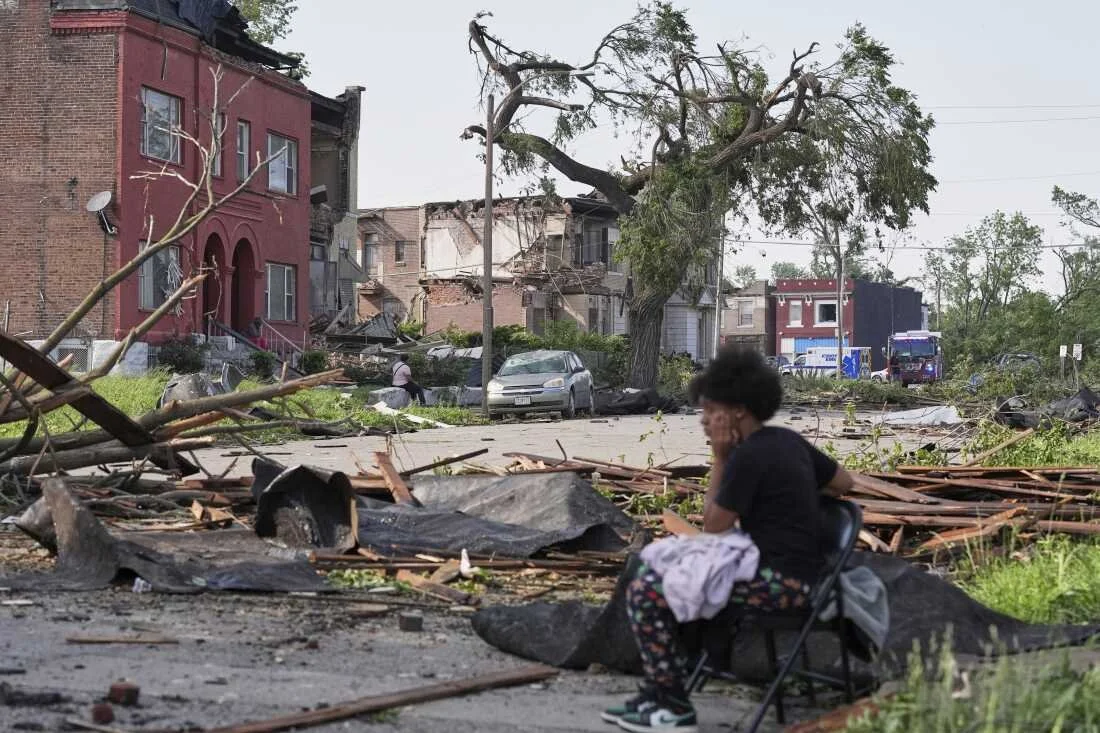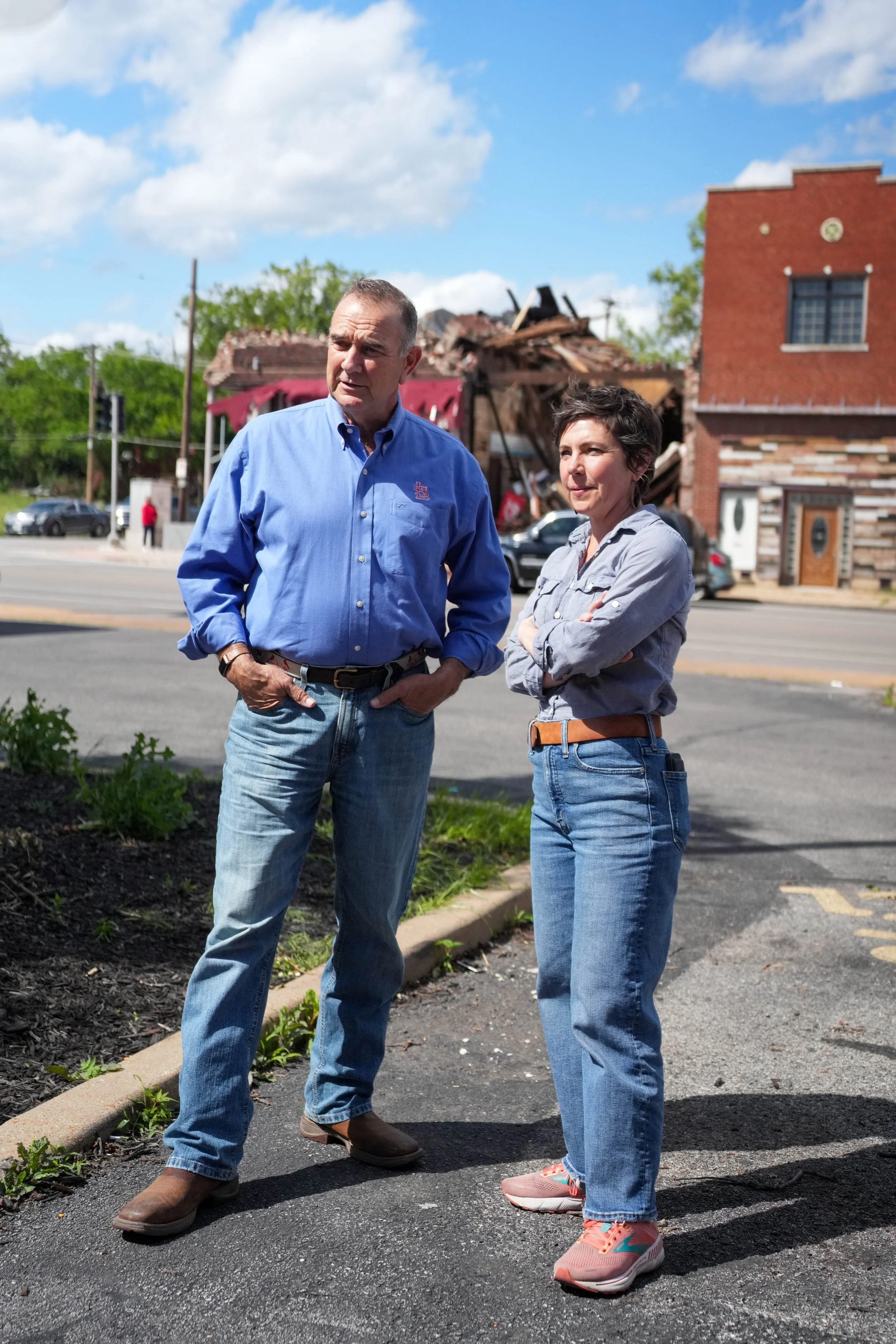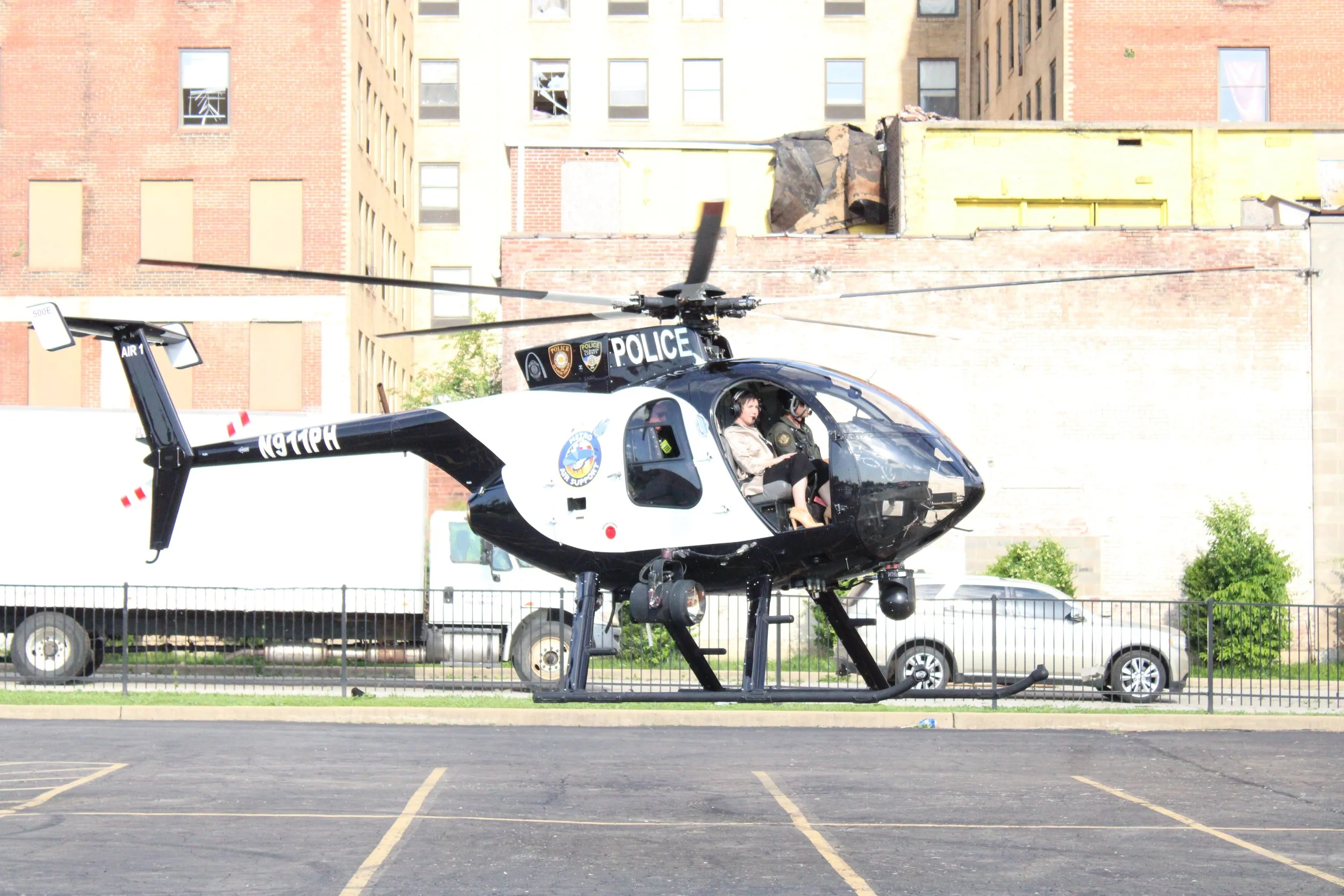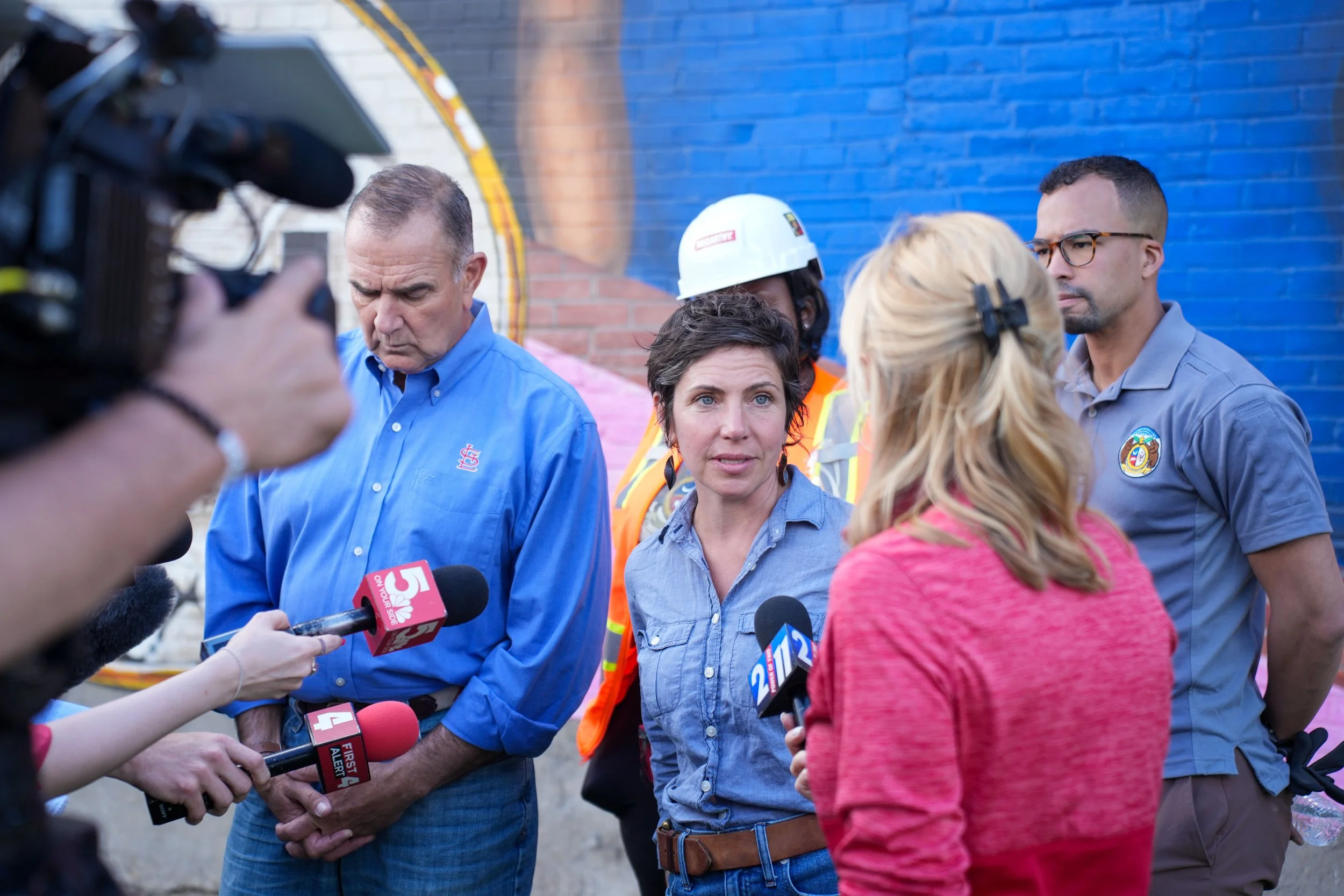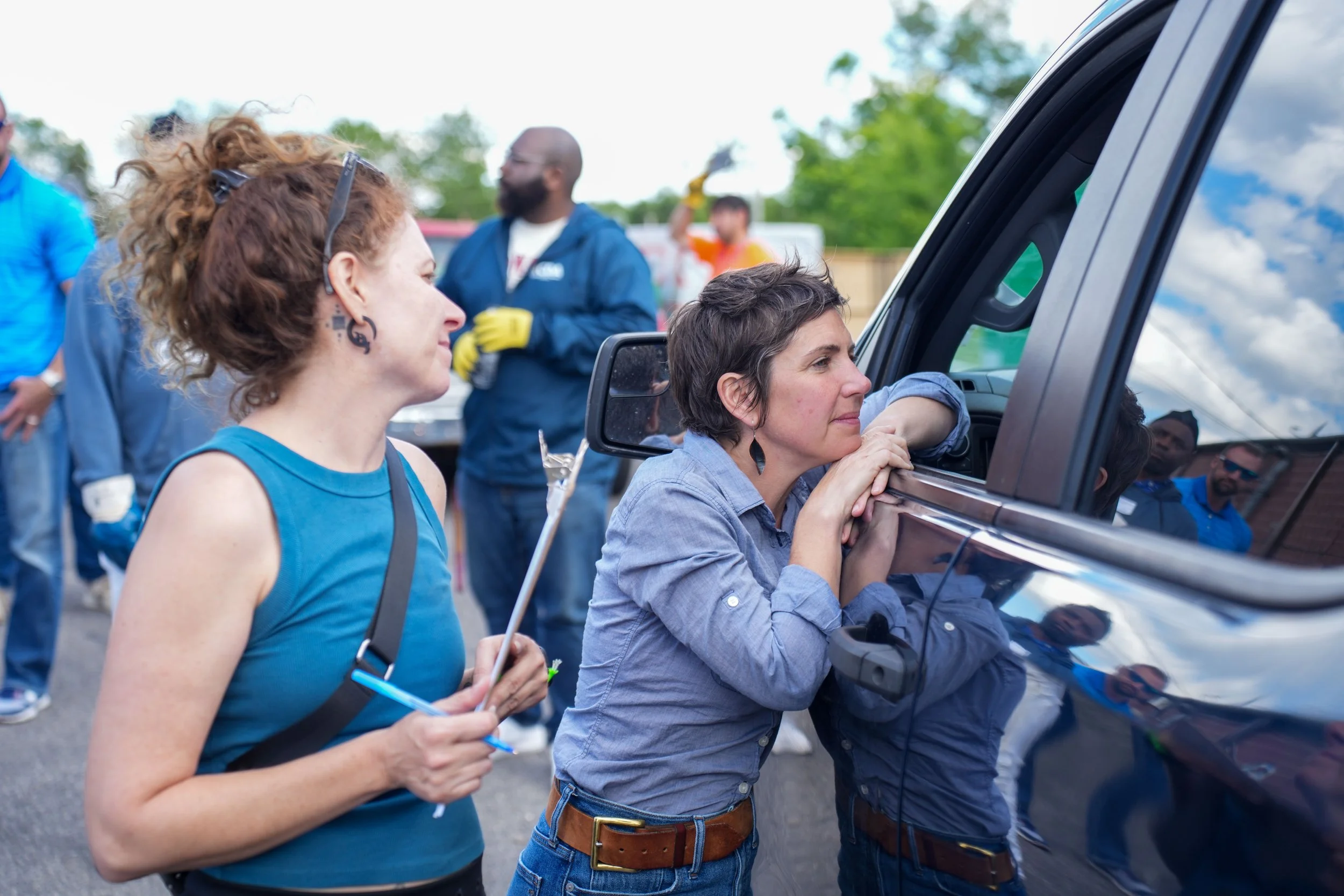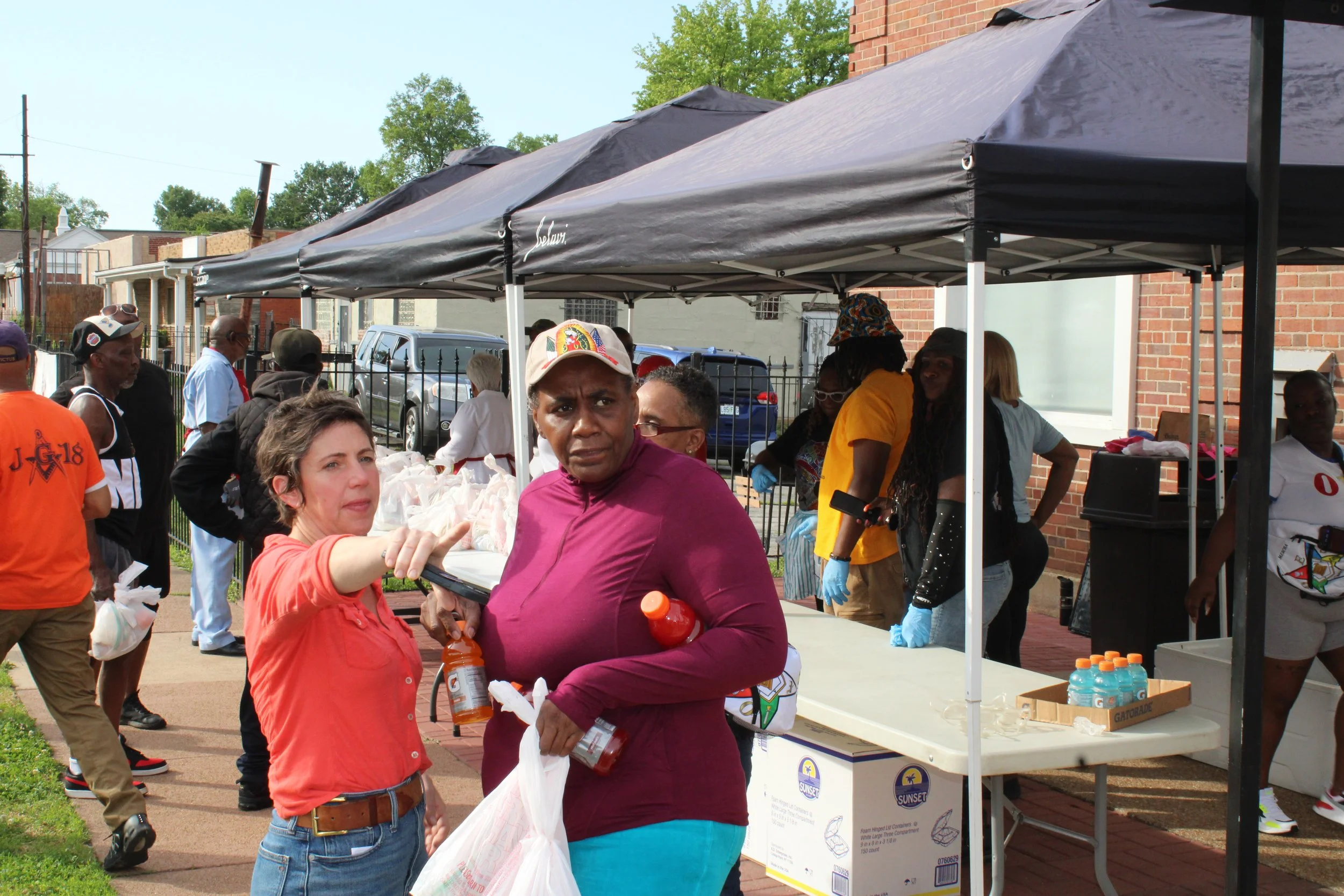Caught in the Eye of the Storm
by Christy Marshall / photographs by John Lore and RJ Hartbeck
When Cara Spencer was a teenager, she used to get in her car and chase tornadoes.
On May 16, 2025, one month and one day after she was sworn in as the 48th mayor of St. Louis, an EF-3 tornado came to her.
With winds of up to 152 miles per hour, the storm ripped through some of the wealthiest and some of the most challenged neighborhoods in the city. Five people died. It left a 23-mile-long swath of destruction in its wake. Approximately 15,000 buildings were affected.
It lasted five minutes. The recovery will take years. And years.
In the aftermath of the May 16, 2025 EF-3 tornado. / photo courtesy of City of St. Louis from NPR
The day the tornado hit, the mayor was at work in City Hall and she received news of the storm around 2:30 p.m. Everyone was ushered to safety within the building. Then the mile-wide tornado touched ground.
“Within minutes, we got a report from the fire department that a tornado had hit the city,” Mayor Spencer said. “It was at that point that we started to gather our team and try to understand just how impactful that tornado was and to meet with our emergency management commanders to understand what was going on and what the next steps were…
Missouri Governor Mike Kehoe surveys the damage with Mayor Cara Spencer.
“You know, it was, was a very, very quick sudden onset. As soon as it came on, that was just as soon as it left. Those of us who were not in the direct path were unaware of just how severe that weather act really was.”
Mayor Spencer would realize the extent quickly. Tree root balls the size of Mini Coopers lined the streets and sidewalks all over the city. Branches jabbed gaping holes into roofs. Cars were crushed. Live power lines crashed onto the streets and sidewalks. Citizens were injured.
Within the hour, Mayor Spencer and her staff headed to the sixth floor of the St. Louis Metropolitan Police Headquarters on Olive Street to set up a command center (Weeks later, the mayor and her staff were still there). The Fire Department immediately set up a first responder response unit at the corner of Delmar and Kingshighway.
Arriving by helicopter to assess the situation.
“Our emergency management team was about four people at the time,” the mayor said. “The first step was staffing up the team with state partners and others well-schooled in “emergency management to help us wrap our head around what to do — and start doing it. That night we brought in all of our department heads, many of them in person, but many of them via Zoom.”
The fire department activated the Regional First Response Unit and dispatched fire departments and EMS “to help us make sure that we were fully addressing the critical, most critical needs, lifesaving needs of folks during those first few hours,” she said.
The mayor and her team headed down to the unit on Delmar to start to assess the damage.
By 8 p.m., a state of emergency had been declared for the City of St. Louis.
Discussing the situation with Aaron Williams with 4theVille and State Senator Steven Roberts.
“The official declaration of a state of emergency unlocked for us and our departments the ability to put people on overtime and to really activate the city’s response in a way that was outside of normal operations,” Mayor Spencer said. “That enabled us to have the parks department, fire department, all these departments over the weekend out in full force to start the massive amount of debris removal that needed to happen so we could make the streets passable again. That was a herculean effort. What the city workers did that weekend and then the following week was truly phenomenal.
“It was all hands-on deck, working 16-to-18-hour days through the first week just to wrap our head around and be the leaders to lead the response and be encouraging to the rest of the city departments to really do the same,” she continued. “And they did. They showed up.” The police force was put on 12-hour days.
Press conferences were held twice a day to start, then daily and now intermittently during the week. If the mayor didn’t have the answer, she didn’t dodge or punt. She simply admitted it and promised to get the information back to the reporter. You could call it trial by fire. Or trial by winds of over 150 miles per hour.
On the scene after the tornado.
Of course, there was that first snafu — the alarms weren’t activated. The then city Emergency Management Agency Commissioner, Sarah Russell, was immediately out; Captain John Walk of the St. Louis Fire Department has assumed the job on an interim basis.
The morning after the storm, Missouri Governor Mike Kehoe flew to the city to review the destruction. He has since been working with the mayor on seeking help from FEMA, an agency President Trump has threatened to disband and where the staff has already been cut.
“We are doing our best and staying steady in our approach, which is unwavering,” Mayor Spencer said. “We know that cities, our city in particular, cannot shoulder alone the burden of dealing with a tornado.” Funds have now come in from both FEMA and the state of Missouri.
A huge warehouse has been leased to serve as a central station for large donations, which will then be parceled out to the various outposts. The mayor has made regular forays into the affected areas. One day she stopped by the Harlen Tap Room, a bar on Natural Bridge Road. Before the tornado it was a three-story building; after the tornado it was one. And when the tornado hit, 15 people were caught inside.
The mayor found a man, clearly shellshocked, sitting in his truck.
He told her that “he had made a lot of bad decisions in his life,” the mayor recalled. “But he made a really good decision that day.” He had pushed those others in the bar to safety. “He felt really, really proud.”
Talking to one of the residents.
Before the tornado, Mayor Spencer had to address residents irate over the fact that the streets weren’t cleared during the snowy January and there were untouched potholes the size of small valleys. Just days before that fateful May 16, she was confronted with the news of a bunch of teenagers in approximately 100 cars creating havoc and fear by erratically driving their cars in South St. Louis.
Spencer came into office with a four-point plan to revitalize the city. The recovery is the unanticipated fifth to-do item — and the one which jettisoned to the top of the list. In early June, the St. Louis aldermen passed the mayor’s bill to allocate $30 million, the interest off the Rams settlement money with the NFL, towards the tornado response.
“We're still in the process of enumerating the buildings damaged, the people displaced and we're going to be working through the long-term recovery in the coming weeks and months,” Mayor Spencer said.
There are also American Rescue Plan Act (ARPA) funds remaining from the aftermath of COVID. “Over the last two weeks, we’ve been going through all remaining funds and identifying funds that could be within the scope of their original encumbrance, directed towards a tornado response in a targeted way,” Mayor Spencer said. “We've started to unroll some of those programs. Yesterday we announced a $5 million package that was earmarked for private building stabilization in all the neighborhoods impacted.”
One of the biggest problems facing the homeowners who lost their homes is the fact that they were underinsured. The mayor explained: “If you look at a three story, 3,000 square foot home, that would under today's cost, be $700,000 or $750,000 to rebuild. But their sale value is maybe $65,000. So, an insurance company isn't going to insure it for the value of the replacement building.”
The mayor at the 4theVille distribution center.
Cara Spencer, now 46 years old, was born on September 11, and grew up loving math. As a result, she is a master at looking at a large problem and breaking it down into smaller components. But when she was in third grade, her teacher, Miss Green, informed her that girls couldn’t be mathematicians. Spencer was determined to prove her wrong (and she went on to major in math at Truman State University).
“I was like, ‘Screw you, Miss Green,’” the mayor recalled.
Life wasn’t all that easy growing up. Her father had a number of jobs including restaurant manager. When Cara was young, he opened an ice cream parlor. Pattie Ann’s (named after his wife) on Telegraph Road. “It failed within a year because it's tough to own a restaurant,” Mayor Spencer said. While it might sound like a dream to have your own ice cream spot, it wasn’t.
“Yeah [it was a dream], except when it bankrupts your parents and then you're living on nothing for a long time,” she said. “My parents didn't climb out of that debt until I was past high school.”
Her mother was a home crafter and Cara “sanded all of the wood products that my parents produced. I had no fingerprints until I got to college and no longer had to sand.”
Formerly an alderwoman, Spencer was elected to office with a resounding defeat of the incumbent, Tishaura Jones, or to be exact, 64 percent of the vote to Jones’ 36 percent. The four goals she stated when she was running were:
1. Provide high quality city services. When asked for specifics, the mayor said: “street repair, potholes, trash pickup, basic city services.”
2. Transform St. Louis into thriving hub opportunities. “So economic transformation means making a city that's growing, a city where you have economic opportunities in every neighborhood. Many of the neighborhoods in our city, many of those impacted by the tornado, don't have the economic opportunities that thriving cities need to have to keep their residents from leaving.”
3. Improving housing, addressing homelessness, supporting workforce growth through immigration and ensuring every child in St. Louis has access to quality education.
4. Make the city safer. “We want to crack down on the very visible crimes like the people doing donuts and taking over the streets.” The mayor praised the police department for their work on that and for “building relationships in some of the most challenged parts of our city.”
Now rebuilding St. Louis city is clearly the number one priority. When asked what residents can do to help, Mayor Spencer didn’t hesitate.
“Be partners in rebuilding St. Louis and in rebuilding north, south and west St. Louis. We're going to be rebuilding our community for many years to come. Continue to be engaged in that process. Continue to support the city. Continue to spread positive messages about the amazing things that happen here.
“Feel good about our hometown.”

